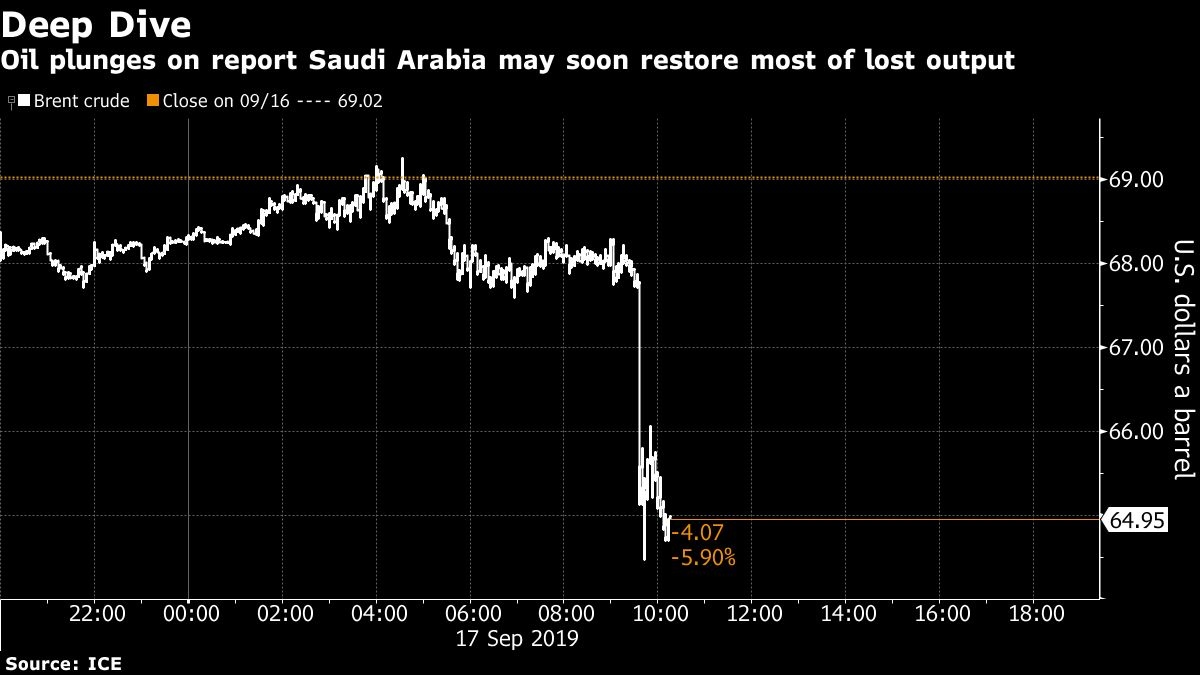Sep 17, 2019
Oil falls on report Saudis may soon resume 70% of lost output
, Bloomberg News
Oil falls on report Saudis may soon resume lost output
Oil plunged nearly 7 per cent in London after Reuters reported Saudi Arabia is close to restoring 70 per cent of the oil production it lost after this weekend’s attack on a key crude facility in the kingdom.
Brent crude dropped to as low as US$64.24 a barrel on the report, which cited an unidentified Saudi source saying the OPEC member would return to full production in the next two to three weeks. Prices recovered some of the loss after CBS News reported that the U.S. has identified locations in Iran from where the attack was launched. Energy Minister Prince Abdulaziz bin Salman is scheduled to hold a press briefing on Tuesday evening in Jeddah.
Estimates of when, and how much, of the 5.7 million barrels a day of shut output would be back online have fluctuated since the attack. Significant volumes could come back within days, people familiar with the matter said over the weekend, adding that it could still take weeks to restore full capacity. Brent futures rose 19 per cent in a matter of seconds at the open on Monday and ended the day up 15 per cent, their biggest single-day advance.

“We flip from worst case scenario to best case scenario in less than 24 hours,” said John Kilduff, partner at New York-based Again Capital LLC. “We still need damage assessments and what it takes for those repairs. The presser for the Saudi energy minister will make or break whether or not we go even lower.“
The attack damaged one of the Saudis’ flagship fields and a key processing complex Saturday, triggering one of the wildest bouts of trading seen in oil markets. The worst ever sudden disruption to global oil supplies continues to reverberate as geopolitical risk premiums soar on concern over instability in the Middle East and a potential retaliation against Iran, which the U.S. has blamed for the strikes.
Brent for November settlement fell US$3.46 to US$65.56 a barrel at 11:29 a.m. New York time on the ICE Futures Europe exchange. The spread between November and December contracts narrowed to as little as 97 cents a barrel, the level it settled at Friday. The U.S. benchmark’s discount to Brent for the same month was US$5.92.
West Texas Intermediate for October delivery slid US$3.15 to US$59.75 a barrel, after declining as much as 6.6 per cent earlier on the New York Mercantile Exchange.
Saudi Aramco is firing up idle offshore oil fields -- part of its cushion of spare capacity -- to replace some of the lost production, a person familiar said earlier. Customers are also being supplied using stockpiles, though some are being asked to accept different grades of crude. The kingdom has enough domestic inventories to cover about 26 days of exports, according to consultant Rystad Energy A/S.
The disruption surpasses the loss of Kuwaiti and Iraqi petroleum output in August 1990, when Saddam Hussein invaded his neighbor. It also exceeds the loss of Iranian oil production in 1979 during the Islamic Revolution, according to the International Energy Agency.
“The Iranians want a higher crude price and to neuter the effect of sanctions so that the world will need and want their oil,” John Hofmeister, former president of Royal Dutch Shell Plc’s US subsidiary, said in an interview in Houston. “The Saudis and the U.S. shouldn’t attack Iran, because that’s exactly what Iran wants. Rather, they should subvert Iran” with cyber attacks and other non-military measures, he said.
--With assistance from Joe Carroll.





